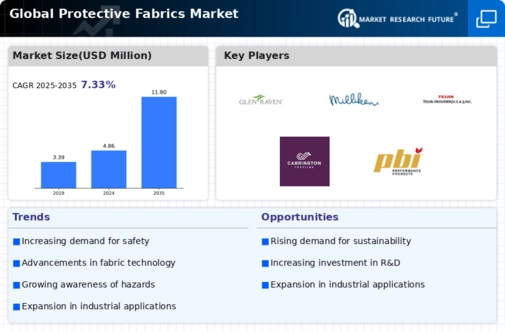Top Industry Leaders in the Protective Fabrics Market

Protective Fabrics Market
Protective fabrics, the guardians of our safety, shield us from the harsh realities of various environments. From firefighters braving infernos to construction workers battling falling debris, these specialized textiles stand as silent heroes, woven into a global market projected to reach the strategies, factors, and developments shaping this dynamic arena.
Strategies Stitching Together Success:
-
Product Diversification: Leading players like DuPont and Honeywell are expanding their portfolios beyond traditional flame-retardant fabrics, developing options with enhanced chemical resistance, cut-proof properties, and bio-hazard protection. This caters to diverse needs and opens new markets. -
Sustainability Focus: Green threads are weaving their way into the market. Companies like TexTech Industries are creating bio-based protective fabrics from renewable materials, minimizing reliance on fossil fuels and aligning with eco-conscious customers. -
Technological Innovation: R&D needles are stitching new threads. Companies like 3M are pioneering nanotechnologies to create fabrics with improved breathability, flexibility, and thermal insulation, pushing the boundaries of safety and comfort. -
Regional Expansion: Asia-Pacific, with its booming construction and manufacturing industries, presents fertile ground. Companies like Toray Industries are setting up production facilities in this region to capitalize on the local demand. -
Strategic Partnerships: Collaboration strengthens the fabric. For instance, W.L. Gore & Associates partnered with a leading oil and gas company to develop customized protective clothing for workers in extreme environments.
Factors Dictating Market Share:
-
Performance Prowess: Superior fire resistance, chemical resistance, cut protection, and breathability are crucial selling points. Established brands like Teijin have built reputations for consistent performance, attracting loyal customers. -
Cost-Effectiveness: Price remains a critical factor, particularly in mature markets. Chinese manufacturers often offer lower prices, challenging established players to optimize production and pricing strategies while maintaining quality. -
Regulatory Landscape: Stringent regulations on workplace safety and environmental standards drive demand for specific protective fabrics. Players who comply with these regulations, like MSA Safety with its flame-retardant and high-visibility fabrics, gain a competitive edge. -
End-Use Applications: Catering to diverse industries offers resilience. Companies with broad product portfolios like Milliken & Company benefit from diversification, mitigating risks in saturated segments.
Key Players:
- 3M (US),
- DuPont (US),
- Lakeland Inc (US),
- Glen Raven Inc.(US),
- Milliken & Company (US),
- Klopman International (Italy),
- Concordia Textiles (Belgium),
- W. L. Gore & Associates GmbH (US),
- TenCate Protective Fabrics (The Netherlands),
- TEIJIN LIMITED (Japan)
Recent Developments:
-
September 2023: Kolon Industries introduces a revolutionary self-healing fabric for protective gloves, enhancing durability and safety for industrial workers. -
October 2023: Teijin Holdings acquires a leading manufacturer of recycled polyester fibers, strengthening its commitment to sustainable protective fabrics solutions. -
November 2023: A team of researchers at MIT develops a new nanomaterial coating for fabrics, granting them superior water and chemical resistance. -
December 2023: W L Gore & Associates announces plans for a new production facility in China, catering to the booming demand for its high-performance fabrics in the region.

